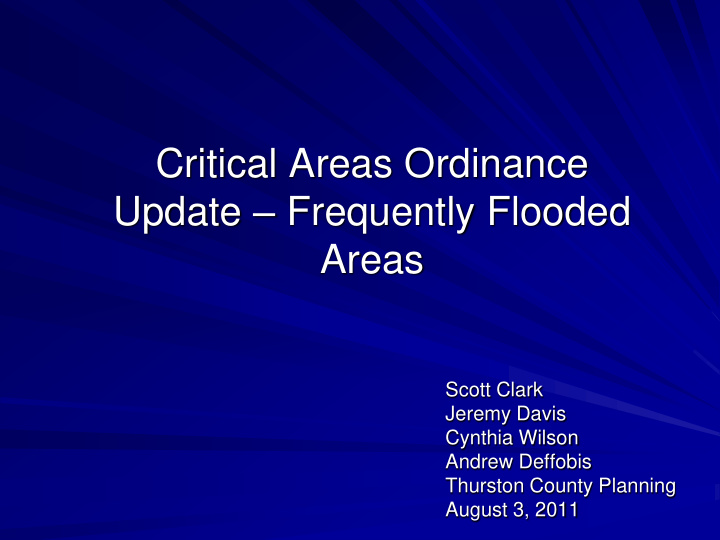



Critical Areas Ordinance Update – Frequently Flooded Areas Scott Clark Jeremy Davis Cynthia Wilson Andrew Deffobis Thurston County Planning August 3, 2011
CAO Update – Status Frequently Flooded Areas chapter distributed tonight – Overview presentation tonight; detailed information found in chapter 24.20 TCC and associated BAS (coming soon) – Work session in future Work continues on draft ordinance, BAS report
Chapter 14.38 – Development in Flood Hazard Areas Existing flood regulations in Title 14 – Building and Construction Proposed CAO chapter 24.20 works in conjunction with chapter 14.38 Chapter 14.38 seeks to prevent damage, death, and injury by limiting development in special flood hazard areas; provides building standards for permitted development
Chapter 14.38 – Development in Flood Hazard Areas Uses base flood elevation (BFE) to determine flood hazard areas – FEMA FIRMs – High Ground Water Flood Hazard Maps – Highest known recorded flood elevation Flood protection elevation is two feet above BFE
Current Flood Hazard Regulations Chapter 14.38; section 17.15.900 TCC – New structures prohibited in floodway; may be permitted on existing lots in 100-year floodplain, subject to standards – Drainfields and wells prohibited in floodway; allowed in floodplain, subject to standards – Replacement of non-conforming structure prohibited in floodway
Proposed Chapter 24.20 Includes standards for floodplain, floodway, channel migration zones, coastal flood and high groundwater hazard areas Modifies high groundwater flood hazard area (HGWFHA) standards Adds standards for channel migration zones (CMZ)
Proposed Chapter 24.20 HGWFHA – No Development and Restricted Development Zones established NDZ = 50 feet from edge of HGWFHA RDZ = area from NDZ out to 2 feet above BFE – RDZ may not exist when topography rises 2 feet within NDZ
Proposed Chapter 24.20 Structures may locate in RDZ in compliance with chapter 14.38 – New on-site septic systems prohibited in RDZ, wells may locate if wellhead is elevated Current code requires 50 foot setback, impervious surface and timber harvest limits (17.15.900 Table 11) – OPTION: Retain standards, modify, remove
Channel Migration Zone Hazard Area Defined as 100 times annual rate of erosion at given point – “100 -year CMZ hazard” Applicant may be required to map CMZ if mapping has not been performed Areas separated from stream by geologic features/structures rated to withstand 100- year flood may be excluded from CMZ hazard area
Channel Migration Zone Hazard Area New development in CMZ hazard area limited to existing lots – Locate outside if possible, otherwise may encroach up to 5,000 SF* – Approval authority determines safety risk *as proposed in draft chapter 24.50 TCC
Proposed Chapter 24.20 Coastal flood hazard areas – Development allowed landward of mean high tide – Structures must be raised three feet above BFE; currently must be elevated to BFE Floodway - Development prohibited (RUE) Floodplain – New primary structures allowed only on existing lots, subject to standards
Questions?
24.15 Geologic Hazards Proposed standard buffer (landslide and marine bluff hazard) is GREATER of following: – 50 feet from toe and top of slope, or: – Distance from toe of slope upward at slope of 2:1 until intersecting with topography of site Ordinary high water mark (OHWM) used for marine bluff hazards – Minimum distance recommended in geotechnical assessment
24.15 Geologic Hazards
17.15 Current CAO Landslide hazards: current CAO requires 50 feet at top, 25 feet at toe of slope – Approval authority may inc. up to 100% based on required reports; may also reduce buffer Marine bluff hazards: current CAO uses greater of 50 feet from top of slope or behind 2:1 slope determination
How do buffers compare? Jurisdictional comparison handout – 50 foot buffers used in some – 2:1 slope used – Height of slope used in some jurisdictions Marine bluffs – Not specifically addressed by most relevant jurisdictions – Landslide/erosion hazard areas may capture
Next Steps Release remaining draft chapters, including: – Critical Area chapters (CARAs, FWHCAs) – Critical Area Tracts and Easements – Special Reports Continue work sessions with Planning Commission
Recommend
More recommend